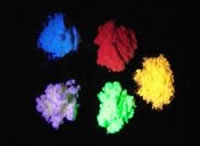A phosphor, a luminophore, or a scintillator is a solid inorganic material that emits light when exposed to an external source of energy. The energy can be in the form of visible radiation (photoluminescence) such as violet, blue, or green light (from an LED, for example). It can also be invisible such as ultraviolet, infrared, or X-ray and gamma radiation. Other types of energy can also energize a phosphor. This can include electron beams (cathodoluminescence), electrical current (electroluminescence), alpha/beta particles (from radiation–emitting radioisotopes), even mechanical friction (triboluminescence).
Most phosphors tend to release the absorbed energy as light fairly quickly within few nanoseconds or microseconds. Other phosphors are slower and have decay times in the milliseconds to several seconds. Some glow-in-the-dark phosphor materials can store energy for hours or even days. These are generally referred to as phosphorescent materials. Photostimulable phosphors (PSPs), sometimes called storage phosphors, are a different class of scintillators that can absorb and store long-term high energy or ionizing radiation (from X-rays, for example). The absorbed energy can later be released in the form of visible light (blue or violet) by stimulating the luminophore using low-energy radiation (red light, for example). This technique is used in some imaging applications such as Computed Radiography.
The most common types of photo-luminescent phosphor materials work by down-conversion where a higher energy photon (e.g, ultraviolet/UV or blue) is converted to lower energy light (green, yellow, red, infrared, etc.). It’s also possible to use a luminophore for converting deep UV (vacuum UV, excimer UV) to UVC or to even lower energy UV such as UVB or UVA radiation.
There are less common types of phosphors referred to as up-conversion materials. During the process of up-conversion, one higher energy photon can be released when two lower energy photons are absorbed. For example, some phosphors can absorb in the infrared and emit in the visible (red/green/blue). Other phosphors can absorb in the visible (e.g, blue) and emit in the ultraviolet (UV), etc.